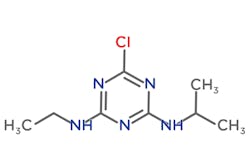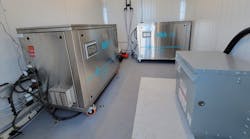What is it?
- Atrazine is a pre- and post-emergent herbicide developed by the Geigy company in 1958. The same chemical is also known by at least 27 other trade names.
- It is a chlorinated triazine consisting of a six-membered aromatic ring like benzene but with alternating carbon and nitrogen atoms (see Figure 1). It also has a chlorine, an ethylamino- and an isopropylamino-group attached to the ring.
- Several related triazines include simazine, propazine and cyanazine.
- Atrazine is among the most widely used agricultural pesticides in the U.S., in the 80 to 90 million pound/year range.
- It is used to control broadleaf weeds on many crops, golf courses and lawns.
- It is slowly degradable in the environment with a half-life of 60 to 160 days in loamy soils and one or two years in reservoirs.
- Atrazine degradation produces two groups of products: chlorinated and hydroxylated.
Occurrence
- Application rates are about 1 pound per acre and have been declining.
- Seasonal runoff to receiving waters can produce increased amounts in streams and drinking water supplies.
- Ongoing tracking of atrazine use areas shows seasonal peaks, but drinking water standards are not usually exceeded.
Health effects
- Numerous regulators and advisory panels worldwide have concluded that atrazine has low toxicity to humans and does not pose a cancer risk.
- A 2011 National Institutes of Health study of more than 36,000 atrazine applicators found no consistent evidence of an association between atrazine use and any cancer site. A suggested increased risk of thyroid cancer was based on relatively small numbers and minimal supporting evidence.
- The health endpoints of interest from rat studies are related to hormonal effects that can affect the estrus cycle and reproductive activity.
- The U.S. Environmental Protection Agency (EPA) is scheduled to provide a revised human risk evaluation in 2016 as part of its pesticide reregistration process.
- There are concerns about atrazine’s effects on fish, amphibians and other environmental biota. The EPA has recently published an ecological risk assessment draft as part of the reregistration review process.
Analysis
- Water analysis methods include gas chromatography/mass spectrometry or liquid chromatography/mass spectrometry with solid-phase extraction and gas chromatography with a nitrogen-phosphorus detector.
Water treatment
- Granular activated carbon, powdered activated carbon (PAC), ozonation, advanced oxidation processes, nanofiltration, reverse osmosis, bank filtration and ultraviolet photolysis can provide varying removals of atrazine from water.
- Conventional water treatment plants have limited removal capability unless PAC is used.
- Appropriate point of use and point of entry devices are available.
Regulations & guidelines
- There is a significant divergence of viewpoints on the acceptable levels of atrazine and metabolites in drinking water.
- The EPA maximum contaminant level goal and maximum contaminant level for atrazine are both 3 micrograms per liter (µg/l). It includes a 1,000 margin of safety and conservatively assumes a 20 percent default contribution from drinking water.
- The World Health Organization (WHO) drinking water guideline value for atrazine and its chlorinated metabolites is 100 µg/l based upon surge suppression of luteinizing hormone in rats, a 100 margin of safety, and 20 percent drinking water contribution.
- The WHO guideline is 200 µg/l for the hydroxylated metabolites based upon kidney toxicity with a 25 margin of safety and 20 percent drinking water contribution.
Dr. Joe Cotruvo is president of Joseph Cotruvo and Associates LLC, water, environment and public health consultants and technical editor of Water Technology. He is a former director of the EPA Drinking Water Standards Division.


